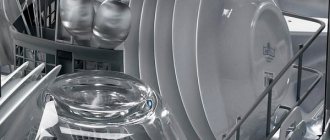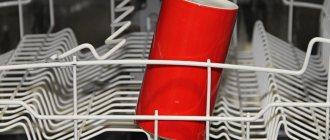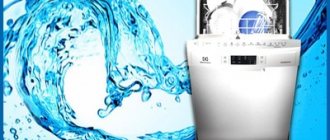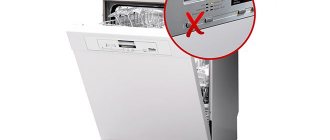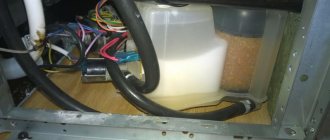The washing program has ended, you are about to take out the dishes, but see that they are wet? Why doesn't my dishwasher dry my cutlery? If your model has drying, but at some point it stops performing its functions, you need to stop working and determine the cause of the problem. Let's look at the problem in more detail; your intervention may not be needed.
The machine does not dry dishes: root causes
To rule out a cause that does not require the help of a specialist, evaluate the situation. Perhaps the wet dishes were caused by your negligence or this is a natural process.
The metal bowls are clean, but there are still drops of water on them. Sound familiar? This means that the machine is in complete order, provided that it has condensation drying. It works simply:
- Upon completion of the washing process, the dishes are rinsed in hot water.
- Water evaporates and settles on the metal walls and parts of the dishwasher body.
- Metal utensils also take the blow.
- Ceramics and glass take longer to cool, unlike metal, so there will be no drops left on dishes made from these materials.
- This phenomenon cannot be eliminated, so you will have to wipe the metal products after washing.
If the machine does not dry well and the dishes remain dirty, then a breakdown is possible. Let's look at the possible reasons for this behavior of the dishwasher below.
Possible reasons why it does not dry
Even if you use the device carefully, it can still break due to wear and tear on parts. Therefore, if problems arise, it is better to have the equipment repaired. Experts will find out which of these parts caused the dishwasher to break down:
Possible reasons for a broken dryer:
- A heating element. When it wears out, communication and power supply are turned off. Provide access to the bottom of the device. Next, dismantle the pallet. Before doing this, it is important to remove the drain pump pipe. The temperature sensor is checked in two ways: visually and using a multimeter. You need to look for external damage. And a special device will show exactly what is wrong with the heating element.
- Thermal sensor. The element is needed so that commands are sent to the heater. Due to its breakdown, water heating stops. The liquid does not have time to reach temperature and the dishes do not dry. As in the case of the heating element, the part is tested with a multimeter. But before diagnosing, you need to release the contacts and fastening. The faulty unit is removed and a new one is installed in its place.
- Control module. If the PMM does not dry, then the reason is a faulty relay. It is responsible for switching modes. The element is not repaired, but replaced immediately.
- A fan that blows heated air. Like the previous part, it is better to replace it with a new one. You can carry out the replacement yourself if you already have experience working with fans. It is necessary to accurately determine the location of the element, turn off the power, and remove the film. Then you need to check for resistance. If there are no mechanical damages or power outages, replacement can be carried out.
Washing dishes in a dishwasher
Breakdowns that caused PMM to stop drying
Most dishwashers, such as Bosch or Electrolux, leave dishes wet due to heating issues. If there is no heating, then:
- in units with condensation drying there is no evaporation of water from the plates;
- in machines with a turbo dryer, the fan blows cold air rather than hot air.
In both the first and second cases, the dishes come out wet. Therefore, failures with drying are similar to malfunctions in which the machine does not heat the water.
Additional symptom: poor quality of washing.
Try using our article to independently determine why the failure occurred. We have collected information about all possible breakdowns in which popular dishwasher models refuse to dry.
Heater failure
- Symptoms: the dishes are wet, poorly washed, the water does not heat up.
- Description: this happens if the heating element in the PMM fails. Most models have a regular heating element, some have a flow-through one. This part is responsible for heating the water and drying. The heating element may burn due to lime deposits.
- How to fix: Replacing the heater with a new element will solve the problem.
Temperature sensor failure
- Symptoms: the same as for a heater failure.
- Description: This sensor is used to measure temperature and transmit data to the main module. The board, in turn, “commands” the heater to start heating. If the sensor fails, the module does not receive information, which is why the heating element does not turn on.
- How to fix: replace the thermistor.
Control board failure
- Symptoms: The machine does not start drying.
- Description: the control module is the fundamental component of any electronically controlled dishwasher. It is he who puts into operation the leading parts and processes in the machine. If the board breaks or malfunctions, the machine may behave incorrectly, including not performing the drying program.
- How to fix: flash or completely replace the board.
Template for Repair Instructions
The turbo drying fan is broken (only for machines with this function)
- Symptoms: you have stopped hearing the usual hum of the fan or hear uncharacteristic sounds during its operation.
- Description: machine models with turbo drying functions involve supplying hot air to the contents of the boxes, due to which it dries quickly and efficiently. When the fan fails, the process does not occur.
- How to fix: replace the fan.
How to replace failed elements in a dishwasher?
Failure heating elements and temperature sensors must be completely replaced; it also happens that the fan, with models of units with turbo drying, is also replaced. After diagnosing the heating element, which is often located at the bottom of the dishwasher, making sure that only by replacing this element will your dishwasher be able to function normally again, we buy an original heater. You can quickly get to the heater by removing the bottom cover of the dishwasher.
You can also determine the performance of the temperature sensor as follows. If, when removing the heating element, it is found to be fully operational, then the cause of the breakdown of the dishwasher is most likely in the temperature sensor. Its function is to regulate the operation of the heating element. The temperature sensor sends commands to the heater, including to dry the dishes. If such a command is not received, then the heating element does not heat up, the drying program does not start and, often, it is during this cycle that the dishwashing process stops completely. The temperature sensor is installed in the opening of the chamber - the water collector. In more modern models, there may also be a sensor indicating the purity of the water. They are different, so it is impossible to confuse them. The wires are first removed from the temperature sensor, and then the device itself is removed. The new element is installed in the reverse order.
If you have a dishwasher from the Korean manufacturer LG , then please note that the temperature sensor in these models is located at the base of the heater.
A common cause of dishwasher failure is a faulty relay. This element is located on the control board. In built-in and free-standing dishwashers, the control module is located in the door. Having removed the control module, you can see the relay; unsolder the contacts and remove it. If you are not sure or have no experience in such work at all, then it is better to turn to professionals, especially since the relay replacement service is an inexpensive repair.
The fan also often becomes a replacement element in dishwashers. Machine manufacturers install it in different places, so there are no clear instructions on how to replace it. You can determine its performance by the characteristic sound during the drying cycle; if it suddenly disappears, then this is the most likely reason why your dishwasher does not dry dishes well. As a rule, in models with turbo drying, when replacing the fan, you have to disassemble almost the entire device.
If you don’t have the skill, contact a specialist, because he will definitely do the job and quite quickly. Keep in mind that if you repair a dishwasher yourself without the appropriate experience, you can cause even more damage, even to the point of having to buy a new dishwasher.
In the article on the site you can also find out what e09 means on the dishwasher display.
The main reasons for poor drying of dishes
The most common reason may be due to improperly loaded dishes. It is necessary to arrange objects in such a way that water flows down. Cups can also turn over during the washing process, so water will accumulate in the dishes, preventing drying. You could also have set the program incorrectly without drying. The second reason is due to insufficient rinsing of dishes after the main wash. For dishwashers, you need to purchase a rinse aid that will remove excess water. If it is not in the machine or is in insufficient quantity, drying does not occur fully. Therefore, it is recommended to check the presence of rinse aid before each wash.
Many problems with dishes not drying properly can be due to broken parts that produce heat. As you know, it is hot air that dries dishes. Dishes can remain wet if water from plates and glasses does not evaporate in machines with a condensation type of drying, and if hot air is not produced in machines with turbo drying. In these cases, the dishes will not dry. If the machine stops heating the water, you need to fix the problem yourself or invite a technician.
Malfunctions associated with improper use of the dishwasher
In order to avoid premature dishwasher malfunctions, you should follow the manufacturer's recommendations. Do not leave leftover food or dried pieces of food on the dishes. The quality of washing in this case will always be superficial. We must try to choose the right washing program. Short modes are intended for dishes that are not heavily soiled. Grease and soot are washed off only during long-term operation at a high temperature.
If you notice that your dishwasher is not washing and drying dishes well, the reason may be that the appliance is overloaded. Try not to burden your assistant so much next time, and maybe the problem will solve itself. There is no point in overloading the machine; it is better to wash it twice, but do it efficiently. You also need to be careful when choosing detergents, and be sure to follow the correct dosage.
If you purchase the wrong cleaning products and rinse aid, then over time the machine will begin to perform poorly. You can try changing the brand of rinse aid to another. If all our advice did not help to correct the situation with poor drying, then you need to start repairing household appliances. Some models can be easily fixed on your own. And if knowledge and skills are not enough, then you can always call a specialist who will bring the dishwasher back to normal.
Previous article What are the advantages of a kitchen apron made of tempered glass Next article How to learn how to fold things correctly, neatly and compactly Manager
Incorrect program selected
Symptoms: drying does not start at all or the dishes remain wet
The simplest reason is that you chose a program that does not involve drying at all. Different drying programs correspond to different types of dishes, and it is possible that you simply made a mistake and set a program that does not correspond to the loaded dishes (or simply forgot to change the program).
Lots of dishes loaded
Symptoms: dryer does not turn on
If you put too many dishes in the chamber, the dishwasher will most likely simply refuse to dry them, being sure that there will be no quality drying anyway. At the end of drying, you need to remove excess dishes and start drying separately.
The car door is not closed
Symptoms: when trying to start a drying program separately, the machine refuses to do so
If the door is not closed or does not fit tightly, the dishwasher will refuse to run the program.
Water doesn't drain well
Symptoms: the drying mode does not turn on or stops
If the water does not drain well from the bunker, naturally, there can be no question of any high-quality drying. If after washing you see water in the chamber, most likely the drain filter is simply clogged and you just need to clean it. But there are a great many reasons for poor drainage, and they are described in detail in our article “The dishwasher does not drain.”
Prevention of breakdowns
So that you don’t have to wonder why the dishwasher doesn’t dry the dishes and look for reasons
Therefore, it is necessary to engage in timely prevention of malfunctions. For proper functioning of a household appliance, you must:
- use it only for its intended purpose;
- as a detergent, use special products intended for this type of unit;
- periodically turn on the machine in test mode using a descaling agent;
- do not load very dirty dishes into the hopper;
- connect the household appliance to the electrical network through a special filter, which will avoid power surges;
- Connect the dishwasher to the network only in the manner specified in the operating instructions
What to do
First you need to find out what's going on. A visual inspection is necessary. Usually the damage is visible to the naked eye. It is worth inspecting the surface of the device and the camera.
Next, it is advisable to use a multimeter. It can be used to determine which element caused the problem. Regardless of which part is broken, you should contact a specialist. During self-repair, many users damage other elements.
Subscribe to TechnoCouncil on social networks so you don’t miss anything:
Causes of malfunction
If, when you open the dishwasher door, you see clean but damp dishes, then do not rush to think that the machine is broken. Most likely, the reason for poor drying of dishes is the type of drying. Most dishwashers have a condensation drying type, which is the cheapest and easiest. This type of drying is also called natural drying. However, condensation drying is not ideal.
The principle of its operation is to evaporate moisture from hot dishes. However, metal objects cool down at the same time as the walls of the tank, which causes condensation to form, which cannot be done about.
For your information! To improve drying, some dishwasher users advise opening the machine door slightly after the end of the program, and also not leaving dishes for a long time so that condensation does not have time to settle.
If the dishes are not only wet, but also poorly washed, then in this case you should think about a serious malfunction.
In machines with condensation drying, this can be:
- breakdown of the heating element, as a result of which the water does not heat up, and therefore the dishes are not washed or dried;
- The temperature sensor is faulty;
- relay failure on the control module.
In the case of dishwashers with turbo dryers, another cause of failure may be the failure of the fan that blows hot air into the chamber with dishes; the result is that the machine does not dry the dishes. Let's now figure out how to fix these problems.
Errors when purchasing
You installed a new inexpensive car at home, started it for the first time - and all the joy from the purchase was gone. The dishes are clean, but they are not dry enough. If real rain does not fall from the plates, but only small drops remain, do not rush to file a claim with the store or demand warranty repairs. Look at the product passport - what kind of drying is indicated there? There are 2 options:
- turbo drying;
- condensation type.
If you see the second option, you yourself chose the wrong dishwasher. Most products have this design; they are simpler and cheaper to manufacture, so they are sold at a low price. When exposed to heat, the water evaporates from the dishes, but moist air remains inside the machine. When the device begins to cool, liquid condenses on both its walls and plates.
Each housewife struggles with this problem in her own way. Some watch when the drying is finished and immediately open the door so that the steam does not remain inside. There are recommendations to remove the dishes as soon as possible, just try not to burn your hands. If, after opening the hatch, you see completely wet or poorly washed dishes, ask for a replacement machine, it is defective.
Advice
To avoid getting into a similar situation, before purchasing any household appliances, read the descriptions and reviews of different brands.
